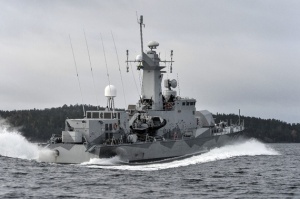Unidentified Underwater Object Hijacks Swedish Headlines
On October 17th, Swedish civilians reported multiple sightings of a mysterious vessel sailing throughout the archipelago approximately 25 miles east of the Swedish capital of Stockholm. Pictures of this unidentified vessel surfaced throughout local newspapers, and the Swedish military was promptly alerted to its existence. After an extensive search, the Swedish navy claimed on October 20th that it had intercepted a Russian distress call from the vessel. The Navy also claimed to have seen air bubbles rising from the surface of the water in close proximity to the vessel’s suspected location: These two pieces of evidence suggested the presence of a Russian submarine, but Russia promptly denied such accusations.
Instead, the latter suggested that the vessel was a Dutch submarine conducting military exercises in the water, but the Netherlands was quick to deny these allegations. For over a week, over 200 naval troops and helicopters scoured Swedish waters in Ingaro Bay, but ultimately the search was called off on October 24th after the Swedish navy failed to uncover any substantive information about the nature or origins of the vessel.
This entire encounter between the Russian and Swedish militaries- one in which tensions flared and quickly subsided- is particularly confusing due to the overwhelming lack of factual information on all sides of the situation.
First, the initial civilian reports of the vessel were extraordinarily unclear. Pictures taken by those who claimed having seen anything were often grainy and distorted. They failed to provide any substantial information that could aid Swedish authorities in locating the allegedly Russian marauders. Furthermore, the number of reported sightings was absolutely staggering. Philip Simon, head of the Swedish Armed Forces, stated that over 250 tips and observations were submitted to the military for review - making it extremely difficult to provide individual analysis.
Second, Swedish military officials were often unclear about the situation themselves. At the beginning of the search, Rear Admiral Anders Grenstad of the Royal Swedish Navy posited a variety of theories about the unidentified vessel, describing how it could be a diver, submarine, or perhaps even a moped-like vehicle. Even when Sweden theorized that a Russian oil tanker sailing in the region could be waiting to aid the Russian submarine, Russia immediately denied such accusations, calling them “baseless.” In light of such resistance, Swedish military officials were often left without strong footing on which to conduct their search. They often struggled to offer theories about the vessel that would not be immediately negated by those accused or distorted by the public.
Still, the most fundamental factor that hindered Sweden’s search was their surprisingly limited maritime military technology. Despite being the world’s third largest exporter of arms per capita, Sweden has minimal anti-submarine warfare technology. During the Cold War, Sweden manufactured an abundance of equipment to counter constant threats from Russia and other Nordic states, yet such research and development has definitely waned since the 1990s. Today, Sweden’s defense budget represents just 1.2% of national GDP, and its maritime military technology has undoubtedly been neglected. General Sverker Goransson of Sweden described this situation as “very serious,” and asked for a change in Swedish military policy. Fortunately, Swedish Prime Minister Stefan Lofven did announce his intention to increase defense spending, specifically in maritime technology, to counter any future threats against Sweden.
When the search for the unidentified vessel was called off on October 24th, Rear Admiral Anders Grenstad calmly stated that those who violated Sweden’s territorial waters’ sovereignty had left. Unfortunately, the situation’s aftermath evokes anything but calmness. Sweden’s failure to identify the vessel reveals a critical point about its precarious position in national security. As a nation which is generally predisposed towards peaceful discourse, Sweden appears remarkably unprepared for acts of international aggression. Not only does it lack the military capabilities to engage in combat against advanced foreign adversaries, but it also lacks the necessary infrastructure to accurately determine the nature of such threats. Hopefully, with greater investment in its defense sector and a heightened realization of vulnerability to foreign aggression, Sweden will be poised to adequately deal with much-needed reforms in the near future.

